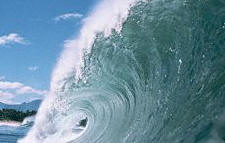Humanity still unable to forecast tsunami
US seismologists warned of a possible tsunami in the Indian Ocean
Over 170 thousand people were killed in the mammoth earthquake and the giant tsunami in the Indian Ocean. Despite the continuing technical progress, the mankind is still defenseless in front of the power of nature. Numerous respectable institutes in a lot of countries of the globe study oceans and the Earth's depth, but it seems that they are unable to protect the world from the natural rage. 
The phenomenon of tsunami is known from ancient times. According to manuscripts, a giant wave destroyed the town of Amnisos on Crete in the year 1400 A.C. The tsunami generated from the eruption of the Volcano of Santorini in the Bronze Age washed away the vast sea-based Minoan civilization. The tragedy was reflected in the legend about the death of Atlantis.
The word “tsunami” is a new word in the Russian language, though. It cannot be found in the dictionary of academician Andrei Zaliznyak, which was published in 1974. The word originates from two Japanese hieroglyphs: “tsu” which means “harbor” and “nami” which means “big wave.” This is the best word to describe the essence of the phenomenon.
The mechanism of tsunami is very simple: it can be compared to a stone that falls down in a pool and causes circles of water around it. Giant waves are caused with earthquakes or volcanic eruptions on the sea floor. A strong quake shocks the water that rests on the bottom of the sea and causes long gravitational waves. The distance between two waves may reach 1,500 km. When a wave appears, it rarely exceeds the height of five meters. That is why sailors may not even notice it in the open sea.
A tsunami wave possesses rather high speed – up to 1,000 kilometers per hour. A wave grows in height as it approaches the coastline. Eighty percent of giant waves occur in the Pacific Ocean.
Scientists started studying giant waves when a seismograph was invented. Boris Levin, the director of the Institute of Sea Geology of the Russian Academy of Sciences, says that a seismic wave develops the speed of 18 thousand kilometers per hour. A tsunami wave is very slow at this point; its speed at the coast is only 70 km/h, which is comparable to a train as it pulls over near a railway station.
The USA established a tsunami-warning center in Hawaii after a devastating wave hit Hawaiian shores in 1960. The center is connected with the satellite line of the monitoring center in Alaska. US seismologists warned of a possible tsunami in the Indian Ocean. However, there is no tsunami-warning system in the countries of Southeast Asia – they simply cannot accept such messages.
Russia has a tsunami service too. The service was established in the beginning of the 1960s. Giant tidal 18-meter waves caused a considerable damagein 1952 in Kamchatka, the Far East, but it became the last occurrence of the kind.
The location of tsunami centers is the most difficult aspect in forecasting the danger of tidal waters. If a wave occurs far from the shore, seismographs are effective. If a giant wave appears somewhere close to the coastline, seismographs are useless. A huge wave of the so-called local tsunami hit the Hawaiian shores in 1960 without any visible reasons. The recent quake in Southeast Asia occurred in the area of the tectonic break, several hundreds of kilometers off Sumatra. It was impossible in this case to save the population of Sri Lanka – the waves hit Sri Lankan shores already in two hours.
There is a hope that it will be possible to solve the problem with the help of the hydroacoustic method, which is currently being developed at the Institute of Sea Geophysics in Russia's Sakhalin region and at the Institute of Mathematical Geophysics in Novosibirsk. For the time being, scientists are working on the tsunami database. American scientists do not think that the tsunami problem is actual for the USA nowadays.
Modern science does not have any effective techniques to forecast devastating tidal waves yet. An ancient Japanese legend says that one should run away from tsunami towards the mountains. Unfortunately, it is still the best defense that the humanity could ever think of. Animals are a lot wiser at this point: they flee the endangered area before the tsunami strikes it.
One of the strongest tsunamis in history devastated the coast of Japan on 15 June 1896. The waves were 35 meters high; 27,000 people were killed, all towns and villages situated on 800 meters along the coast were demolished. Tsunamis in the Indian Ocean are less frequent than in the Pacific Ocean, although their destructive capacity is the same.
Giant tidal waves are extremely rare in Europe. A large 30-meter high wave struck Lisbon in 1755 and killed one-fourth of the city's 200,000 population. A powerful tsunami was registered in Sicily in 1908.
The UN's conference devoted to the issue of diminishing the damage caused by natural disasters will take place in Kobe, Japan, at the end of January. It is expected that experts will decide to create a global tsunami-warning system for the Indian Ocean. Some experts believe that one should develop a system of beacon sensors in the Pacific, Indian, Atlantic Oceans and in the Caribbean Sea. The Global Disaster Information Network of the US Department of State will be in charge of the project. Australia is working on its own system. The system will consist of 30 seismographs, 10 ebb-and-flow sensors and six special beacons. It is not ruled out it will be more difficult to create a system to notify and evacuate people in case of emergency.
Subscribe to Pravda.Ru Telegram channel, Facebook, RSS!





